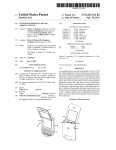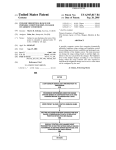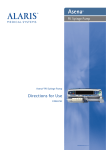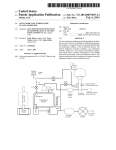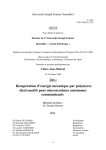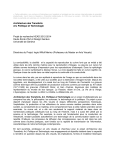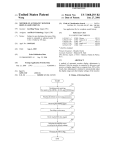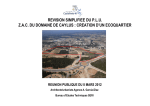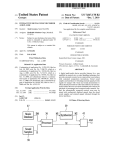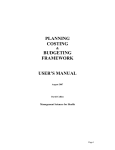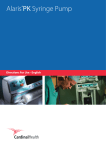Download Method and apparatus for automatic power-up and power
Transcript
US007626582B1 (12) Ulllted States Patent (10) Patent N0.: Nicolas et al. (54) US 7,626,582 B1 (45) Date of Patent: Dec. 1, 2009 METHOD AND APPARATUS FOR 5,615,259 A 3/1997 Gilbert AUTOMATIC POWER-UP AND POWER-DOWN OF AN ELECTRONIC 5,646,649 A 5,750,939 A 7/1997 Iwata et al. 5/1998 MakinWa et al. DEVICE 5,756,941 A * (75) 73 ( Inventors: Regis Nicolas, Jacou (FR); Neal Osborn, Milpitas, CA (US) A ) (*) _ ' P l sslgnee' I S 1 CA a m’ nc" unnyva e’ Notice: S (U ) Subject to any disclaimer, the term of this patent is extended or adjusted under 35 5/1998 Snell ..................... .. 178/1901 5,796,827 A 5,838,138 A 55/1993 COPPeTSmith et a1~ 11/1998 Henty 5,845,161 A * 12/1998 Schrock et a1. ........... .. 396/313 5,889,888 A 3/1999 Marianetti, 11 et al. 5,894,580 A 4/1999 Yoshida U.S.C. 154(b) by 210 days. (21) Appl. N0.: 11/385,984 (22) Filed: (Continued) Mar. 20,2006 Related U_s_ Application Data _ (63) _ _ _ OTHER PUBLICATIONS Pelrine, et al.; Dielectric Elastomers: Generator Mode Fundamentals and Applications, Mar. 4-8, 2001, Proceedings of SPIE vol. 4329. Cont1nuat1on of appl1cat1on No. 11/ 125,543, ?led on May 9, 2005, noW Pat. No. 7,046,237, Which is a continuation of application No. 09/522,274, ?led on Mar. 9, 2000, noW Pat. NO. 6,924,791. (Continued) _ _ _ _ Prlmary ExammeriRlchard HJerPe Assistant ExamineriMansour M Said (51) Int. Cl. G09G 5/00 (52) (58) US. Cl. ...................... .. 345/204; 345/173; 345/179 Field of Classi?cation Search ............... .. 345/156, (2006.01) 345/ 158, 169, 173*179; 178/ 18.01, 18.03, 178/18.09, 19.01, 19.07, 20.01; 455/90, 455559, 572, 574; 708/107, 109, 149; 713/321 (56) (57) ABSTRACT A method and apparatus for automatic poWer-up and poWer down ofan electronic device is disclosed. More speci?cally, an electronic device may be automatically poWered-up in See appl1cat1on ?le for Complete Search 11151013’References Cited response to removal of a user interface object from a portion of a housing of the electronic device. The electronic device may be placed in a poWer conservation mode When the user US. PATENT DOCUMENTS interface object is placed in the portion of the housing of the 4,857,916 A 4,897,873 A 5,049,862 A 5,067,573 A * 5,117,073 A 5,179,502 A 5,278,993 A 5,483,262 A * 5,584,054 A 8/1989 Bellin 1/1990 Beutler et a1. 9/1991 Dao et al. 11/1991 Uchida ..................... .. 345/173 5/1992 Mischenko 1/1993 Matsuda 1/1994 Reiff et al. 1/1996 electronic device. The electronic device may include a cover operable to cover a display device of the electronic device, Where the electronic device may be automatically poWered up in response to uncovering the display device. The elec tronic device may be placed in a poWer conservation mode When the display device is covered by the cover. IZutani ..................... .. 345/179 12/1996 Tyneski et al. 27 Claims, 17 Drawing Sheets US 7,626,582 B1 Page 2 U.S. PATENT DOCUMENTS 6,924,791 B1 * 7,046,237 B1 * 5,900,875 A 6,016,476 A 5/1999 Haitani et al. 1/2000 Maes et al. 6,100,538 A * 8/2000 Ogawa ................ .. 250/55929 6,101,608 A 6,160,540 A 8/2000 Schmidt et al. 12/2000 Fishkin et a1. 7,124,300 Bi 8/2005 Nicolas et al. ............ .. 345/179 5/2006 Nicolas et al. ............ .. 345/179 10/2006 Lemke OTHER PUBLICATIONS Kornbluh, et al.; Electroelastomers: Applications of Dielectric 6,233,464 B1 * 5/2001 Chmaytelli ............ .. 455/5562 Elastomer Transducers for Actuation, Generation and Smart Struc 6,243,074 B1 6,243,075 B1 6,246,577 B1 6/2001 Fishkin et al. 6/2001 Fishkin et a1. 6/2001 Han et al. tures, Mar. 4-8, 2001. pdQ Basics Handbook. http://WWWqualcommcom. Qualcomm Incorporated San Diego, CA. pp. 1-96. 6,392,639 B1 * 5/2002 Lee 6t 31. .................. .. 345/179 Sprint PCS, User Guide, 1999 Sprint Spectrum, pp, l-ll9, 6,411,283 B1 6,434,403 B1 6,618,806 B1 6/2002 Murphy 8/2002 Ausems et al. 9/2003 Brown et al. StarTAC 3000. User Manual. * cited by examiner 1999 US. Patent Dec. 1, 2009 Sheet 2 0f 17 US 7,626,582 B1 F2AIGURE US. Patent Dec. 1, 2009 Sheet 3 0f 17 US 7,626,582 B1 MmmDGE US. Patent Dec. 1, 2009 Sheet 4 0f 17 US 7,626,582 B1 F3IGURE US. Patent Dec. 1, 2009 Sheet 5 0f 17 l2 FIGURE 4 US 7,626,582 B1 US. Patent Dec. 1, 2009 Sheet 6 6f 17 US 7,626,582 B1 .525:m .2528 a @F253,» H52 :s ie EzcH6“ $25 25 8 in 2:2; 25.: a? 2% 2: a? $352K meséz A ES1E52: we. MmDQE US. Patent Dec. 1, 2009 Sheet 7 0f 17 / 305 PILOT , Edit ' New Memo Delete Memo... Bill Davidson to s tudy programs as Options N D impact implmen ted by ti e management yees. Michelle Baker to report on expanding career markets in the Dallas Fort Worth area. FIGURE 6 US 7,626,582 B1 US. Patent Dec. 1, 2009 Sheet 8 0f 17 1f|. mH 0 l|I 5 .d 3lW0 \v4 w_ Q FIGURE 7 US 7,626,582 B1 US. Patent Dec. 1, 2009 Sheet 9 0f 17 FIGURE 8 US 7,626,582 B1 US. Patent Dec. 1, 2009 Sheet 10 0f 17 COMPUTER IN POWER DOWN STATE (POWER CONSERVATION MODE) §_2_O YES POWER ON IRO? E <——-— YES ON-OFF KEY PRESSED? 6_3_O_ STYLUS REMOVED? @ YES V AUTOMATIC POWER UP OF COMPUTER SYSTEM w FIGURE 9A US 7,626,582 B1 US. Patent Dec. 1, 2009 Sheet 11 0117 COMPUTER IN POWER UP STATE w YES <——— YES ON-OPF KEY PRESSED? AUTOMATIC POWER DOWN OF COMPUTER SYSTEM _b6_5 FIGURE 98 US 7,626,582 B1 US. Patent Dec. 1, 2009 Sheet 12 0f 17 39% m FIGURE 10 US 7,626,582 B1 US. Patent Dec. 1, 2009 Sheet 13 0f 17 US 7,626,582 B1 M:EDGE US. Patent Dec. 1, 2009 Sheet 14 0f 17 COMPUTER IN POWER DOWN STATE [POWER CONSERVATION MODE) '14_5 YES POWER ON IRO? m <——— YES ON-OI‘I' KEY PRESSED? 155 INCE ROTATED COVER OPEN? M YES Y AUTOMATIC POWER UP OF COMPUTER SYSTEM l?? FIGURE 12A US 7,626,582 B1 <— US. Patent Dec. 1, 2009 Sheet 15 0f 17 US 7,626,582 B1 COMPUTER IN POWER UP STATE 13B YES <————— YES ON-OFF KEY PRESSED'? 1119 HINGE ROTRTED COVER 01.0w)? NO YES + _ AUTOMATIC POWER DOWN or COMPUTER SYSTEM 7 m FIGURE 12B US. Patent Dec. 1, 2009 Sheet 16 6f 17 US 7,626,582 B1 M2DOE US. Patent Dec. 1, 2009 Sheet 17 0f 17 US 7,626,582 B1 m3DmvE US 7,626,582 B1 1 2 METHOD AND APPARATUS FOR AUTOMATIC POWER-UP AND POWER-DOWN OF AN ELECTRONIC DEVICE arrangement alloWs a user to hold the palmtop computer system in one hand While Writing With the pen onto the digi tiZer pad With the other hand. A number of palmtop computer systems that rely on the pen and digitiZer pad combination as the primary means of input have been introduced to the market. Most of these This patent application is a Continuation of co-pending, commonly-oWned patent application Ser. No. 11/125,543, pen-based palmtop computer systems provide some type of ?led on May 9, 2005, now US. Pat. No. 7,046,237 entitled “METHOD AND APPARATUS FOR AUTOMATIC POWER-UP AND POWER-DOWN OF A COMPUTER SYSTEM BASED ON THE POSITIONS OF AN ASSOCI handwriting recognition system Whereby the user can Write Words and letters on the digitiZer pad With a stylus. The palmtop computer system then converts the user’s handWrit ATED STYLUS AND/OR HINGE”, by Regis Nicolas and Neal Osborn, Which is incorporated herein by reference, and acters. Examples of pen-based palmtop computer systems that provide handwriting recognition include the Apple NeW Which is a Continuation of US. patent application Ser. No. 09/522,274, now US. Pat. No. 6,924,791, ?led on Mar. 9, 2000, entitled “METHOD AND APPARATUS FOR AUTO MATIC POWER-UP AND POWER-DOWN OF A COM PUTER SYSTEM BASED ON THE POSITIONS OF AN ton (trademark) device and the Tandy Zoomer (trademark) ing into a machine readable format such as ASCII code char device. DigitiZers have eliminated the need for a mechanical key board device. Therefore, palmtop computer systems are ASSOCIATED STYLUSAND/ OR HINGE”, by Regis Nico las and Neal Osborn. 20 readily portable and can easily be carried on or near the user, e.g., in a pocket, purse or briefcase. Since they can be carried by a user, the user has many opportunities to use the palmtop computer during the day. Since the palmtop computer is typi cally battery operated, it is recommended to turn off the computer at the completion of each separate use. As such, each time the palmtop is used, an on/off button is typically BACKGROUND OF THE INVENTION 1. Field of the Invention The present invention relates to the ?eld of computer sys tems that utiliZe a digitizer and stylus. More speci?cally, the present invention relates to poWer-on and poWer-off mecha 25 nisms for portable computer systems that utiliZe a digitizer and an associated stylus or that have a cover. 2. Related Art 30 the palmtop computer. If the palmtop computer is being used As the components required to build a computer system have reduced in siZe, neW categories of computer systems have emerged. One of the neW categories of computer sys tems is the “palmtop” computer system. A palmtop computer system is a computer that is small enough to be held in the merely to access (or amend or transmit) a small bit of infor mation and then turned off, the process of pressing the on/off button tWice can be a substantial amount of the user’s task just 35 hand of a user and can therefore be “palm-sized.” Most palm top computer systems are used to implement various Personal Information Management (PIM) applications such as an address book, a daily organiZer and electronic notepads, to name a feW. Palmtop computers With PIM softWare have been Users alWays Want easier Ways and mechanisms to access 40 and making use of a palmtop computer system is open to Wide consumer acceptance. Therefore, it Would be advantageous to make easier and less tedious the user’s tasks in accessing information from a palmtop computer system. 45 SUMMARY OF THE INVENTION Data entry on a palmtop computer has been a challenge. small that a user cannot touch-type. Furthermore, to use a Accordingly, What is needed is an improvement that reduces the number of repetitive tasks required of a user in keyboard device, a user must either place the palmtop com puter system doWn onto a ?at surface, so the user can type With both hands, or the user holds the palmtop computer order to obtain information and make use of a palmtop com 50 system With tWo hands and types With thumbs only. Instead of a mechanical keyboard device, some palmtop 55 screen. The user then interacts With the on- screen small key board image to enter characters, usually one character at a time. To interact With the displayed keyboard image (e.g., “virtual keyboard”), the user taps the screen location of a character With a pen or stylus. That corresponding character is 60 then recogniZed and added to a data entry ?eld, also displayed on the screen. HoWever, for experienced users, the virtual keyboard input system can be a tedious input process. Instead of using a mechanical keyboard device or a dis played keyboard, many palmtop computers employ a pen and a digitiZer pad as an input system. The pen and digitiZer pad combination Works Well for palmtop computers because the puter system. What is needed is a method and system that reduces the repetitive tasks required in turning on and turning off the palmtop computer system. The present invention pro vides these advantages and others not speci?cally mentioned computers utiliZe a touch screen and display an image of a small keyboard thereon. When a particular button is pressed or tapped, a small keyboard image is displayed on the display to obtain or amend the desired information thereby rendering tedious the use of the computer. information on the palmtop computer. Any improvement that reduces the user’s repetitive tasks in obtaining information knoW as Personal Digital Assistants (PDAs). Since palmtop computer systems are very small, full-siZed keyboards are generally not e?icient input devices. Palmtop computers using keyboards have keyboard devices that are so pressed to turn on poWer to the computer system, including the display device. Therefore, each time the palmtop com puter is to be used, the on/off button is pressed and after use the on/off button is pressed again to turn off the palmtop computer. The more times the computer is used, the more times the on/ off button needs to be pressed to gain access to above but described in the sections to folloW. A method and system are described for automatic poWer up and automatic poWer-doWn of a computer system based on the position and/ or rotation of an associated stylus and/or hinge. In one embodiment, the computer system is a portable computer having a logic board, a display screen, a digitiZer and a receiving slot for an associated stylus. The stylus is used With the digitiZer in Well knoWn character recognition modes. When the stylus is removed from the receiving slot, a sWitch automatically turns full poWer onto the computer system thereby alloWing a user full use of the computer Without 65 requiring an on/off button to be pressed. When the stylus is inserted back into the receiving slot, the sWitch automatically returns the computer to a poWer reduction mode Where one or


























